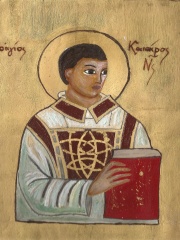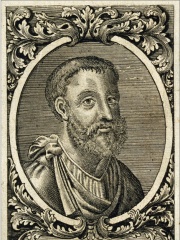
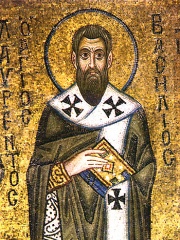
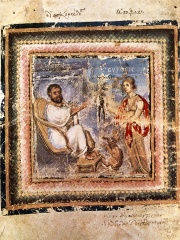
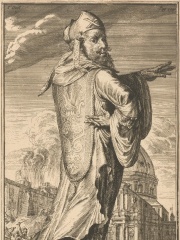
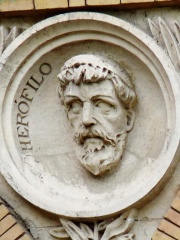

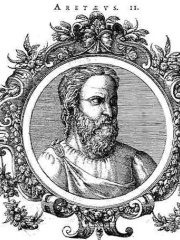

The Most Famous
PHYSICIANS from Türkiye
This page contains a list of the greatest Turkish Physicians. The pantheon dataset contains 726 Physicians, 18 of which were born in Türkiye. This makes Türkiye the birth place of the 7th most number of Physicians behind Italy, and Poland.
Top 10
The following people are considered by Pantheon to be the top 10 most legendary Turkish Physicians of all time. This list of famous Turkish Physicians is sorted by HPI (Historical Popularity Index), a metric that aggregates information on a biography's online popularity. Visit the rankings page to view the entire list of Turkish Physicians.

1. Galen (129 - 215)
With an HPI of 85.73, Galen is the most famous Turkish Physician. His biography has been translated into 113 different languages on wikipedia.
Aelius Galenus or Claudius Galenus (Greek: Κλαύδιος Γαληνός; September 129 – c. 216 AD), often anglicized as Galen () or Galen of Pergamon, was a Roman and Greek physician, surgeon, and philosopher. Considered to be one of the most accomplished of all medical researchers of antiquity, Galen influenced the development of various scientific disciplines, including anatomy, physiology, pathology, pharmacology, and neurology, as well as philosophy and logic. The son of Aelius Nicon, a wealthy Greek architect with scholarly interests, Galen received a comprehensive education that prepared him for a successful career as a physician and philosopher. Born in the ancient city of Pergamon (present-day Bergama, Turkey), Galen traveled extensively, exposing himself to a wide variety of medical theories and discoveries before settling in Rome, where he served prominent members of Roman society and eventually was given the position of personal physician to several emperors. Galen's understanding of anatomy and medicine was principally influenced by the contemporary theory of the four humors: black bile, yellow bile, blood, and phlegm, as first advanced by the author of On the Nature of Man in the Hippocratic corpus. Galen's views dominated and influenced Western medical science for more than 1,300 years. His anatomical reports were based mainly on the dissection of Barbary apes. However, while dissections and vivisections on humans were practiced in Alexandria by Herophilus and Erasistratus in the 3rd century BCE under Ptolemaic permission, by Galen's time these procedures were strictly forbidden in the Roman Empire. As Galen discovered that the facial expressions of the Barbary apes were particularly vivid, Galen switched to pigs for his research to avoid prosecution. Aristotle had used pigs centuries earlier for his study of anatomy and physiology. Galen, like others, reasoned that animal anatomy had a strong conciliance with that of humans. Galen would encourage his students to go look at dead gladiators or bodies that washed up in order to get better acquainted with the human body. Galen's theory of the physiology of the circulatory system remained unchallenged until c. 1242, when Ibn al-Nafis published his book Sharh tashrih al-qanun li' Ibn Sina (Commentary on Anatomy in Avicenna's Canon), in which he reported his discovery of pulmonary circulation. His anatomical reports remained uncontested until 1543, when printed descriptions and illustrations of human dissections were published in the seminal work De humani corporis fabrica by Andreas Vesalius, where Galen's physiological theory was accommodated to these new observations. Galen saw himself as both a physician and a philosopher, as he wrote in his treatise titled That the Best Physician Is Also a Philosopher. Galen was very interested in the debate between the rationalist and empiricist medical sects, and his use of direct observation, dissection, and vivisection represents a complex middle ground between the extremes of those two viewpoints. Many of his works have been preserved or translated from the original Greek, although many were destroyed and some credited to him are believed to be spurious. Although there is some debate over the date of his death, he was no younger than seventy when he died.

2. Basil of Caesarea (329 - 379)
With an HPI of 82.87, Basil of Caesarea is the 2nd most famous Turkish Physician. His biography has been translated into 70 different languages.
Basil of Caesarea, also called Saint Basil the Great (330 – 1 or 2 January 379) was an early Roman Christian prelate who served as Bishop of Caesarea in Cappadocia from 370 until his death in 379. He was an influential theologian who supported the Nicene Creed and opposed heresies within the early Christian church such as Arianism and Apollinarianism. In addition to his work as a theologian, Basil was known for his care of the poor and underprivileged. Basil established guidelines for monastic life which focus on community life, liturgical prayer, and manual labor. Together with Pachomius, he is remembered as a father of communal monasticism in Eastern Christianity. He is considered a saint by the traditions of both Eastern and Western Christianity. Basil, together with his brother Gregory of Nyssa and his friend Gregory of Nazianzus, are collectively referred to as the Cappadocian Fathers. The Eastern Orthodox Church and Eastern Catholic Churches have given him, together with Gregory of Nazianzus and John Chrysostom, the title of Great Hierarch. He is recognized as a Doctor of the Church in the Roman Catholic Church. He is sometimes referred to by the epithet Ouranophantor (Greek: Οὐρανοφάντωρ), "revealer of heavenly mysteries".

3. Pedanius Dioscorides (40 - 90)
With an HPI of 77.86, Pedanius Dioscorides is the 3rd most famous Turkish Physician. His biography has been translated into 48 different languages.
Pedanius Dioscorides (Ancient Greek: Πεδάνιος Διοσκουρίδης, Pedánios Dioskourídēs; c. 40–90 AD), "the father of pharmacognosy", was a Greek physician, pharmacologist, botanist, and author of De materia medica (in the original Ancient Greek: Περὶ ὕλης ἰατρικῆς, Peri hulēs iatrikēs, both meaning "On Medical Material") , a 5-volume Greek encyclopedic pharmacopeia on herbal medicine and related medicinal substances, that was widely read for more than 1,500 years. For almost two millennia Dioscorides was regarded as the most prominent writer on plants and plant drugs.

4. Nestorius (381 - 451)
With an HPI of 77.67, Nestorius is the 4th most famous Turkish Physician. His biography has been translated into 62 different languages.
Nestorius of Constantinople (; Ancient Greek: Νεστόριος; c. 386 – c. 451) was an early Christian prelate who served as Archbishop of Constantinople from 10 April 428 to 11 July 431. He was a Christian theologian from the Catechetical School of Antioch, and several of his teachings in the fields of Christology and Mariology were seen as controversial and heretical, causing major disputes. In 431, he was condemned and deposed from his see by the Council of Ephesus, presided over by his archrival Cyril of Alexandria, but the counter-council led by John I of Antioch vindicated him and deposed Cyril in return. Nestorius refrained from attending both of these councils and instead sought retirement from the Byzantine Emperor. Nestorius himself used the title Theotokos and did not advocate for its ban. His teachings included cautious usage of Theotokos ("God-Bearer"), used for Mary, mother of Jesus, in order that Christ's human and divine natures not be confused, as he believed Christ was born according to his humanity and not his divinity, which indicated his preference for the concept of the prosopic union of two natures (divine and human) of Christ, over the concept of a hypostatic union. He proposed instead the title of Christotokos ("Christ-bearer"). This brought him into conflict with Cyril of Alexandria and other prominent diophysite and miaphysite churchmen of the time, who accused him of heresy. If the babe and the Lord of the babe are one and the same person, the suspected phrase "inhabitant of the babe" must be simply intended as a safeguard against identification of the Word with the flesh. So Mary is Theotokos – because the Word was united to the temple ... which is in nature consubstantial with the holy Virgin ... It is in virtue of this union that the holy Virgin is called Theotokos Nestorius sought to defend himself at the Council of Ephesus in 431, but instead found himself formally condemned for heresy by a majority of the bishops and was subsequently removed from his see. On his own request, he retired to his former monastery, in or near Antioch. In 435, Theodosius II sent him into exile in Upper Egypt, where he lived on until about 451, strenuously defending his views. His last major defender within the Roman Empire, Theodoret of Cyrrhus, finally agreed to anathematize him in 451 during the Council of Chalcedon. From then on, he had no defenders within the empire, but the Church of the East in the Persian Empire never accepted his condemnation. That led later Western Christians to give the name Nestorian Church to the Church of the East where his teachings were deemed orthodox and in line with its own teachings. Nestorius is revered as among three "Greek Teachers" (in addition to Diodorus of Tarsus and Theodore of Mopsuestia) of the Church of the East. The East Syriac Eucharistic Service, which is known to be among the oldest in the world, incorporates prayers attributed to Nestorius himself. The discovery, translation and publication of his Bazaar of Heracleides at the beginning of the 20th century have led to a reassessment of his theology in Western scholarship. It is now argued by some scholars and clergy that his ideas are compatible with later Chalcedonian theology and/or his condemnation at Ephesus was misplaced, but the orthodoxy of his formulation of the doctrine of Christ is still controversial.
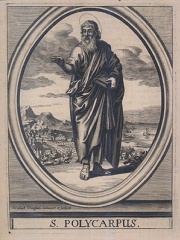
5. Polycarp (69 - 155)
With an HPI of 74.49, Polycarp is the 5th most famous Turkish Physician. His biography has been translated into 55 different languages.
Polycarp (; Greek: Πολύκαρπος, Polýkarpos; Latin: Polycarpus; AD 69 – 155) was a Christian bishop of Smyrna. According to the Martyrdom of Polycarp, he died a martyr, bound and burned at the stake, then stabbed when the fire failed to consume his body. Polycarp is regarded as a saint and Church Father in the Eastern Orthodox Church, the Catholic Church, Oriental Orthodox Churches, Lutheranism, and Anglicanism. Both Irenaeus and Tertullian say that Polycarp had been a disciple of John the Apostle, one of Jesus's disciples. In On Illustrious Men, Jerome similarly writes that Polycarp was a disciple of John the Apostle, who had ordained him as a bishop of Smyrna. Polycarp is regarded as one of three chief Apostolic Fathers, along with Clement of Rome and Ignatius of Antioch.

6. Herophilos (335 BC - 280 BC)
With an HPI of 72.17, Herophilos is the 6th most famous Turkish Physician. His biography has been translated into 37 different languages.
Herophilos (; Ancient Greek: Ἡρόφιλος; 335–280 BC), sometimes Latinised Herophilus, was a Greek physician regarded as one of the earliest anatomists. Born in Chalcedon, he spent the majority of his life in Alexandria. He was the first scientist to systematically perform scientific dissections of human cadavers. He recorded his findings in over nine works, which are now all lost. The early Christian author Tertullian states that Herophilos vivisected at least 600 prisoners; however, this account has been disputed by many historians. He is often seen as the father of anatomy.

7. Ctesias (440 BC - 400 BC)
With an HPI of 71.06, Ctesias is the 7th most famous Turkish Physician. His biography has been translated into 42 different languages.
Ctesias ( TEE-zhəs; Ancient Greek: Κτησίᾱς, romanized: Ktēsíās; fl. 5th century BC), also known as Ctesias of Cnidus, was a Greek physician and historian from the town of Cnidus in Caria, then part of the Achaemenid Empire.

8. Aretaeus of Cappadocia (100 - 200)
With an HPI of 66.68, Aretaeus of Cappadocia is the 8th most famous Turkish Physician. His biography has been translated into 25 different languages.
Aretaeus (Ancient Greek: Ἀρεταῖος) is one of the most celebrated of the ancient Greek physicians. Little is known of his life. He was ethnically Greek, born in the Roman province of Cappadocia, Asia Minor (modern day Turkey), and most likely lived in the second half of the second century AD. He is generally styled "the Cappadocian" (Καππάδοξ).

9. Soranus of Ephesus (98 - 200)
With an HPI of 65.48, Soranus of Ephesus is the 9th most famous Turkish Physician. His biography has been translated into 25 different languages.
Soranus of Ephesus (Ancient Greek: Σωρανός ὁ Ἑφέσιος; fl. 1st/2nd century AD) was a Greek physician. He was born in Ephesus but practiced in Alexandria and subsequently in Rome, and was one of the chief representatives of the Methodic school of medicine. Several of his writings still survive, most notably his four-volume treatise on gynecology, and a Latin translation of his On Acute and Chronic Diseases.
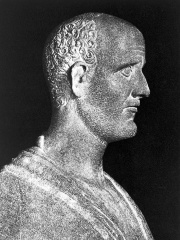
10. Asclepiades of Bithynia (120 BC - 40 BC)
With an HPI of 65.31, Asclepiades of Bithynia is the 10th most famous Turkish Physician. His biography has been translated into 23 different languages.
Asclepiades (Greek: Ἀσκληπιάδης; c. 129/124 BC – 40 BC), sometimes called Asclepiades of Bithynia or Asclepiades of Prusa, was a Greek physician born at Prusias-on-Sea in Bithynia in Anatolia and who flourished at Rome, where he practised and taught Greek medicine. He attempted to build a new theory of disease, based on the flow of "atoms" through pores in the body. His treatments sought to restore harmony through the use of diet, exercise, and bathing. Biographer Antonio Cocchi noted that there were over forty men of history with the name Asclepiades and wrote that physician Caius Calpurnius Asclepiades of Prusa, born 88 CE, was a fellow countryman of, and perhaps a direct descendant of this Asclepiades.
People
Pantheon has 18 people classified as Turkish physicians born between 440 BC and 1935. Of these 18, none of them are still alive today. The most famous deceased Turkish physicians include Galen, Basil of Caesarea, and Pedanius Dioscorides.
Deceased Turkish Physicians
Go to all RankingsGalen
129 - 215
HPI: 85.73
Basil of Caesarea
329 - 379
HPI: 82.87
Pedanius Dioscorides
40 - 90
HPI: 77.86
Nestorius
381 - 451
HPI: 77.67
Polycarp
69 - 155
HPI: 74.49
Herophilos
335 BC - 280 BC
HPI: 72.17
Ctesias
440 BC - 400 BC
HPI: 71.06
Aretaeus of Cappadocia
100 - 200
HPI: 66.68
Soranus of Ephesus
98 - 200
HPI: 65.48
Asclepiades of Bithynia
120 BC - 40 BC
HPI: 65.31
Caesarius of Nazianzus
330 - 368
HPI: 63.29
Aëtius of Amida
502 - 575
HPI: 62.15
Overlapping Lives
Which Physicians were alive at the same time? This visualization shows the lifespans of the 4 most globally memorable Physicians since 1700.

